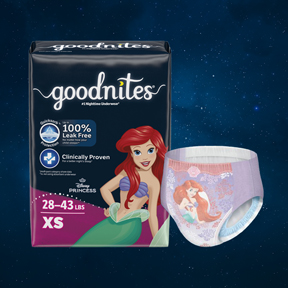Transition From Potty Training
Is My Child Potty Training or Nighttime Wetting?
2 Nov, 2022
2 min. Read
If your child has been potty training, they may be wearing Pull-Ups® training pants as they transition from diapers to underwear — or on occasions when they’re away from home and want extra protection in case of an accident. But what about wetting at night? Are there night time Pull-Ups? And what’s the best option for a child who wets the bed but no longer has accidents during the day?
With so many options available, it can be difficult to determine which product is right for your growing child, especially when their struggles to stay dry at night may already be causing them unnecessary anxiety. Answering the four quick questions in the above quiz will help determine if your child is still potty training or experiencing bedwetting. Based on the results, the quiz will offer advice on which product would work best for them to help ease their worries and keep them feeling dry and comfortable.
If you or your child is concerned about bedwetting, talk to your doctor. They may recommend a visit to a pediatric urologist to rule out any possible medical conditions. Yet don’t worry too much. According to Dr. Charles Sophy, medical director for the Los Angeles County Department of Children and Family Services, less than 3% of bedwetting is related to a medical or psychological problem.
With so many options available, it can be difficult to determine which product is right for your growing child, especially when their struggles to stay dry at night may already be causing them unnecessary anxiety. Answering the four quick questions in the above quiz will help determine if your child is still potty training or experiencing bedwetting. Based on the results, the quiz will offer advice on which product would work best for them to help ease their worries and keep them feeling dry and comfortable.
When Do Kids Finish Potty Training?
Like walking, talking, or reading, potty training happens at different times for different kids. Most parents should start looking for signs of potty training readiness around 24 months. And once families start the process, it usually takes about 8 months. About half of kids are completely potty trained at age 3 (other than the occasional accident, of course!), but some finish around age 3½. Usually girls are trained about three months earlier than boys. Many parents think finishing potty training will mean kids are dry at night too, not just during the day. But nighttime dryness is a completely different process. It’s highly connected to physical development. Your child’s bladder needs to grow big enough, and it needs to send signals to and from the brain communicating when they need to wake up during the night to use the bathroom.How Is Bedwetting Different than Daytime Potty Accidents?
Nighttime wetting may be a medical condition called nocturnal enuresis. More than 5 million children in the U.S. continue to wet the bed past the age of 6, according to the National Kidney Foundation, and most of them simply outgrow it. Kids can wet the bed for a variety of reasons:- Being a deep sleeper. Your child may not realize they need to pee, or they might find it difficult to wake up.
- Producing too much urine during the night.
- Having a small or “irritable” bladder. Your child’s bladder may contract too easily, or the nerves that control the bladder may be slow to mature.
- Genetics. Sometimes bedwetting runs in families. If you, your parents, or your siblings had issues with bedwetting, it’s not surprising that your child is also wetting the bed. If one parent wet the bed after 5 years old, their children have about 40% chance of bedwetting. If both parents wet the bed as children, their children have about a 70% chance of bedwetting.
- A medical condition. A urinary tract infection (UTI), constipation, bladder or kidney disease, a structural problem in the urinary system or nervous system, diabetes, obstructive sleep apnea, hormone imbalance, attention-deficit/hyperactivity disorder (ADHD), stress or anxiety could be causing bedwetting.










